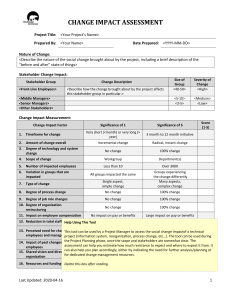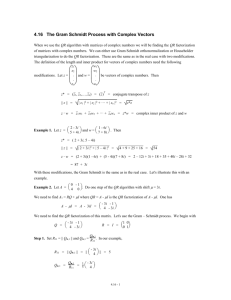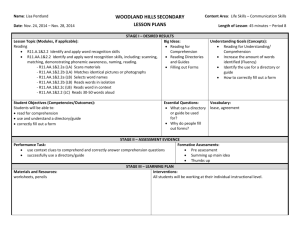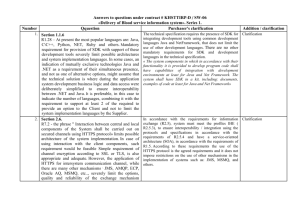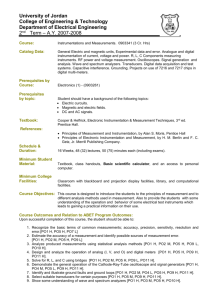Feb 15
advertisement
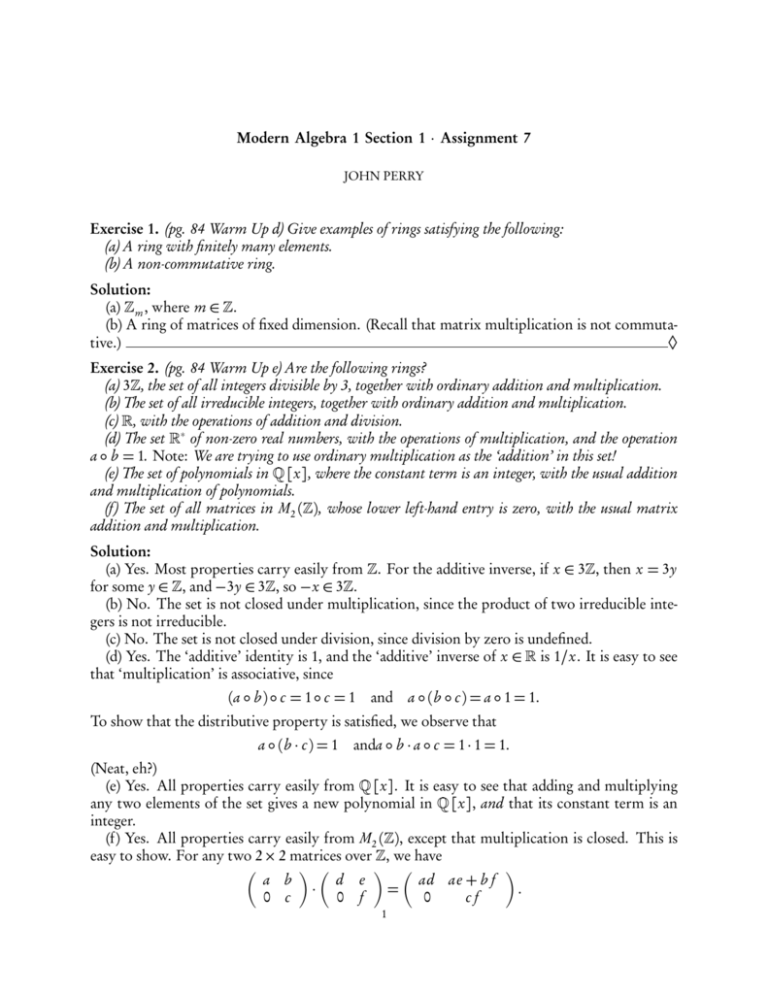
Modern Algebra 1 Section 1 · Assignment 7
JOHN PERRY
Exercise 1. (pg. 84 Warm Up d) Give examples of rings satisfying the following:
(a) A ring with finitely many elements.
(b) A non-commutative ring.
Solution:
(a) Z m , where m ∈ Z.
(b) A ring of matrices of fixed dimension. (Recall that matrix multiplication is not commuta◊
tive.)
Exercise 2. (pg. 84 Warm Up e) Are the following rings?
(a) 3Z, the set of all integers divisible by 3, together with ordinary addition and multiplication.
(b) The set of all irreducible integers, together with ordinary addition and multiplication.
(c) R, with the operations of addition and division.
(d) The set R∗ of non-zero real numbers, with the operations of multiplication, and the operation
a ◦ b = 1. Note: We are trying to use ordinary multiplication as the ‘addition’ in this set!
(e) The set of polynomials in Q [x], where the constant term is an integer, with the usual addition
and multiplication of polynomials.
(f ) The set of all matrices in M2 (Z), whose lower left-hand entry is zero, with the usual matrix
addition and multiplication.
Solution:
(a) Yes. Most properties carry easily from Z. For the additive inverse, if x ∈ 3Z, then x = 3y
for some y ∈ Z, and −3y ∈ 3Z, so −x ∈ 3Z.
(b) No. The set is not closed under multiplication, since the product of two irreducible integers is not irreducible.
(c) No. The set is not closed under division, since division by zero is undefined.
(d) Yes. The ‘additive’ identity is 1, and the ‘additive’ inverse of x ∈ R is 1/x. It is easy to see
that ‘multiplication’ is associative, since
(a ◦ b ) ◦ c = 1 ◦ c = 1
and a ◦ (b ◦ c) = a ◦ 1 = 1.
To show that the distributive property is satisfied, we observe that
a ◦ (b · c) = 1
anda ◦ b · a ◦ c = 1 · 1 = 1.
(Neat, eh?)
(e) Yes. All properties carry easily from Q [x]. It is easy to see that adding and multiplying
any two elements of the set gives a new polynomial in Q [x], and that its constant term is an
integer.
(f) Yes. All properties carry easily from M2 (Z), except that multiplication is closed. This is
easy to show. For any two 2 × 2 matrices over Z, we have
a b
d e
ad ae + b f
·
=
.
0 c
0 f
0
cf
1
Modern Algebra 1 Section 1 · Assignment 7 · John Perry
2
◊
Exercise 3. (pg. 85 Exercise 1) Show that in a ring, 0a = a0 = 0.
Solution:
Let R be an arbitary ring. Let a ∈ R be arbitary, but fixed. Certainly 0 + 0 = 0. Multiply on
the right to both sides and distribute:
0a = (0 + 0) a
0a = 0a + 0a.
Since 0a = 0a + 0,
0a + 0 = 0a + 0a
and by Theorem 6.1(a)
0 = 0a.
A similar argument shows that a0 = 0.
◊
Exercise 4. (pg. 85 Exercise 3) Show that in a ring, (−a) b = a (−b ) = − (ab ).
Solution:
Let R be an arbitrary ring. Let a, b ∈ R be arbitrary, but fixed. First we show that (−a) b =
− (a b ). Apply the distributive property, the additive inverse property, and the result of Exercise
3 to obtain
ab + (−a) b = (a + (−a)) b = 0b = 0.
Thus (−a) b is the additive inverse of ab ; that is, (−a) b = − (ab ).
A similar argument shows that a (−b ) = − (ab ).
◊
Exercise 5. (pg. 85 Exercise 4) Show that in a ring, (−a) (−b ) = ab .
Solution:
Let R be an arbitrary ring. Let a, b ∈ R be arbitrary, but fixed. Apply the result of Exercise 4
to obtain
(−a) (−b ) = − (a (−b )) = − (− (ab )) = ab .
(The last equality follows from Theorem 6.1(c). That is, the inverse of − (ab ) is ab , which is
how they are inverse in the first place!)
◊
Exercise 6. (pg. 85 Exercise 5) Prove the following facts about subtraction in a ring R, where a, b , c ∈
R:
(a) a − a = 0.
(b) a (b − c) = ab − ac.
(c) (b − c) a = (b a − ca).
Solution:
(a) By definition, a − a = a + (−a) = 0.
(b) Use distribution and the result of Exercise 4 to obtain
a (b − c) = a (b + (−c)) = ab + a (−c) = ab + (− (ac)) = ab − ac.
(c) An argument similar to that of (b) works.
◊
Modern Algebra 1 Section 1 · Assignment 7 · John Perry
3
Exercise 7. (pg. 86, Exercise 12) Let
Z [i] = {a + b i ∈ C : a, b ∈ Z} .
Show that Z [i] is a commutative ring (see Exercise 11). This is called the ring of Gaussian integers.
Solution:
Addition and multiplication, defined as in Exercise 11, give Gaussian integers: Let x, y ∈ Z [i].
Then x = a + b i and y = c + d i for some a, b , c, d ∈ Z. We see that
x + y = (a + b i) + (c + d i)
= (a + c) + (b + d ) i
and
xy = (a + b i) (c + d i)
= ac + ad i + b c i − b d
= (ac − b d ) + (ad + b c) i.
Since the integers are closed under addition and multiplication, x + y, xy ∈ Z [i]. Since x, y were
arbitrary in Z [i], it follows that Z [i] is closed under addition and multiplication.
Now we show that Z [i] satisfies the six properties of a ring. Let x, y, z ∈ Z [i] be arbitrary,
but fixed. Let a, b , c, d , e, f ∈ Z such that x = a + b i, y = c + d i, and z = e + f i.
(Rule 1) By definition,
x + y = (a + b i) + (c + d i) = (a + c) + (b + d ) i.
Since the integers are commutative under addition,
x + y = (c + a) + (d + b ) i = (c + d i) + (a + b i) = y + x.
(Rule 2) By definition,
(x + y) + z = ((a + c) + (b + d ) i) + (e + f i) = ((a + c) + e) + ((b + d ) + f ) i.
Since the integers are associative under addition,
(x + y) + z = (a + (c + e)) + (b + (d + f )) i
= (a + b i) + ((c + e) + (d + f ) i)
= (a + b i) + ((c + d i) + (e + f i))
= x + (y + z) .
(Rule 3) The zero element of Z [i] is 0 + 0i, since
x + (0 + 0i) = (a + b i) + (0 + 0i) = (a + 0) + (b + 0) i = a + b i.
(Rule 4) The inverse of x is −a + (−b ) i, since
x + (−a + (−b ) i) = (a + b i) + (−a + (−b ) i) = (a + (−a)) + (b + (−b )) i = 0 + 0i.
Modern Algebra 1 Section 1 · Assignment 7 · John Perry
4
(Rule 5) By definition,
(xy) z = ((a + b i) (c + d i)) (e + f i)
= ((ac − b d ) + (ad + b c) i) (e + f i)
= ((ac − b d ) e − (ad + b c) f ) + ((ac − b d ) f + (ad + b c) e) i
= (a (c e − d f ) − b (d e + c f )) + (a (c f + d e) + b (−d f + c e)) i
= (a + b i) ((c e − d f ) + (c f + d e) i)
= (a + b i) ((c + d i) (e + f i))
= x (y z) .
(It might be easier to simplify (xy) z and x (y z) and show that they are equal.)
(Rule 6) By definition,
x (y + z) = (a + b i) ((c + d i) + (e + f i))
= (a + b i) ((c + e) + (d + f ) i)
= (a (c + e) − b (d + f )) + (a (d + f ) + b (c + e)) i
= (ac + ae − b d − b f ) + (ad + a f + b c + b e) i
= (ac − b d ) + (ae − b f ) + (ad + b c) i + (b c + b e) i
= ((ac − b d ) + (ad + b c) i) + ((ae − b f ) + (b c + b e) i)
= xy + x z.
(As with Rule 5, it might be easier to simplify x (y + z) and xy + x z and show that they are
equal.)
◊
Exercise 8. (pg. 87, Exercise 15) Verify that Example 6.10 is a ring. Namely, let R and S be arbitrary
rings. Define addition and multiplication appropriately to make R × S a ring, where R × S is the
set of ordered pairs with first entry from R and second entry from S. Now generalize this to the set
R1 × R2 × · · · × Rn of n-tuples with entries from the rings Ri . This new ring is called the direct
product of the rings Ri .
Solution:
We will prove that R1 × R2 × · · · × Rn is a ring under the operations
r11 , r12 , . . . , r1n + r21 , r22 , . . . , r2n = r11 + r21 , r12 + r22 , . . . , r1n + r2n
r11 , r12 , . . . , r1n r21 , r22 , . . . , r2n = r11 r21 , r12 r22 , . . . , r1n r2n .
Since Ri is closed uner addition and multiplication for each i : 1 ≤ i ≤ n, R1 × R2 × · · · × Rn are
closed under addition and multiplication.
We now show that the six properties of a ring are satisfied. Let r1 , r2 , r3 ∈ R1 × R2 × · · · × Rn
be arbitrary, but fixed.
Modern Algebra 1 Section 1 · Assignment 7 · John Perry
5
(Rule 1) That addition is commutative,
r1 + r2 = r11 , r12 , . . . , r1n + r21 , r22 , . . . , r2n
= r11 + r21 , r12 + r22 , . . . , r1n + r2n
= r21 + r11 , r22 + r12 , . . . , r2n + r1n
= r21 , r22 , . . . , r2n + r11 , r12 , . . . , r1n
= r1 + r2 .
(1)
(2)
Notice that we used the commutative property of R1 , R2 , ..., Rn when moving from line (1) to
line (2).
(Rule 2) That addition is associative,
(3)
(4)
r1 + (r2 + r3 ) = r11 , r12 , . . . , r1n + r21 , r22 , . . . , r2n + r31 , r32 , . . . , r3n
= r11 , r12 , . . . , r1n + r21 + r31 , r22 + r32 , . . . , r2n + r3n
= r11 + (r21 + r31 ) , r12 + (r22 + r32 ) , . . . , r1n + r2n + r3n
= (r11 + r21 ) + r31 , (r12 + r22 ) + r32 , . . . , r1n + r2n + r3n
= r11 + r21 , r12 + r22 , . . . , r1n + r2n + r31 , r32 , . . . , r3n
= r11 , r12 , . . . , r1n + r21 , r22 , . . . , r2n + r31 , r32 , . . . , r3n
= (r1 + r2 ) + r3 .
Notice that we used the associative property of R1 , R2 , ..., Rn when moving from line (3) to line
(4).
(Rule 3) Let z = (0, 0, . . . , 0). Notice that z ∈ R1 × R2 × · · · × Rn since each of R1 , R2 , ..., Rn has
a zero element. Then
r1 + z = r11 , r12 , . . . , r1n + (0, 0, . . . , 0)
= r11 + 0, r12 + 0, . . . , r1n + 0
= r11 , r12 , . . . , r1n
= r1 .
Hence z is a zero element of R1 × R2 × · ·· × Rn .
(Rule 4) Let n = −r11 , −r12 , . . . , −r1n . Notice that n ∈ R1 × R2 × · · · × Rn since r11 has an
additive inverse in R1 , r12 has an additive inverse in R2 , . . . , r1n has an additive inverse in Rn .
Then
r1 + n = r11 , r12 , . . . , r1n + −r11 , −r12 , . . . , −r1n
= r11 + (−r11 ) , r12 + (−r12 ) , . . . , r1n + −r1n
= (0, 0, . . . , 0) .
Hence n = −r1 .
Modern Algebra 1 Section 1 · Assignment 7 · John Perry
6
(Rule 5) That multiplication is associative,
r1 (r2 r3 ) = r11 , r12 , . . . , r1n
r21 , r22 , . . . , r2n r31 , r32 , . . . , r3n
= r11 , r12 , . . . , r1n r21 r31 , r22 r32 , . . . , r2n r3n
= r11 (r21 r31 ) , r12 (r22 r32 ) , . . . , r1n r2n r3n
(5)
= (r11 r21 ) r31 , (r12 r22 ) r32 , . . . , r1n r2n r3n
(6)
= r11 r21 , r12 r22 , . . . , r1n r2n r31 , r32 , . . . , r3n
= r11 , r12 , . . . , r1n r21 , r22 , . . . , r2n
r31 , r32 , . . . , r3n
= (r1 r2 ) r3 .
Notice that we used the associative property of R1 , R2 , ..., Rn when moving from line (5) to line
(6).
(Rule 6) That there is distribution,
r21 , r22 , . . . , r2n + r31 , r32 , . . . , r3n
r1 (r2 + r3 ) = r11 , r12 , . . . , r1n
= r11 , r12 , . . . , r1n r21 + r31 , r22 + r32 , . . . , r2n + r3n
(7)
= r11 (r21 + r31 ) , r12 (r22 + r32 ) , . . . , r1n r2n + r3n
(8)
= r11 r21 + r11 r31 , r12 r22 + r12 r32 , . . . , r1n r2n + r1n r3n
= r11 r21 , r12 r22 , . . . , r1n r2n + r11 r31 , r12 r32 , . . . , r1n r3n
= r11 , r12 , . . . , r1n r21 , r22 , . . . , r2n + r11 , r12 , . . . , r1n r31 , r32 , . . . , r3n
= r1 r2 + r1 r3 .
Notice that we used the distributive property of R1 , R2 , ..., Rn when moving from line (7) to line
(8).
We have shown that r1 , r2 , r3 satisfy the six properties of a ring. Since these are arbitrary
elements of R1 × R2 × · · · × Rn , it is a ring.
◊
Exercise 9. s(pg. 87 Exercise 18) Suppose that a · a = a for every element a in a ring R. (Elements a
in a ring where a 2 = a are called idempotent.)
(a) Show that a = −a.
(b) Now show that R is commutative.
Solution:
(a) If a · a = a for every element a ∈ R, then
a + a = (a + a)2
= (a + a) (a + b )
= a2 + a2 + a2 + a2
= a + a + a + a.
Apply the definition of zero and Theorem 6.1(a) to obtain
(a + a) + 0 = (a + a) + (a + a)
0 = a + a.
Since a + a = 0, it must be that a is its own additive inverse. In symbols, a = −a.
Modern Algebra 1 Section 1 · Assignment 7 · John Perry
7
(b) Using the same approach,
a + b = (a + b )2
= (a + b ) (a + b )
= a 2 + ab + b a + b 2
= (a + b ) + (ab + b a) .
(Notice that we do not assume that ab = b a, because we are trying to prove this!) Thus
(a + b ) + 0 = (a + b ) + (ab + b a)
0 = ab + b a.
Hence a b = − (b a). We showed in part (a) that every element of R is its own additive inverse,
so − (b a) = b a. Hence ab = b a.
◊
